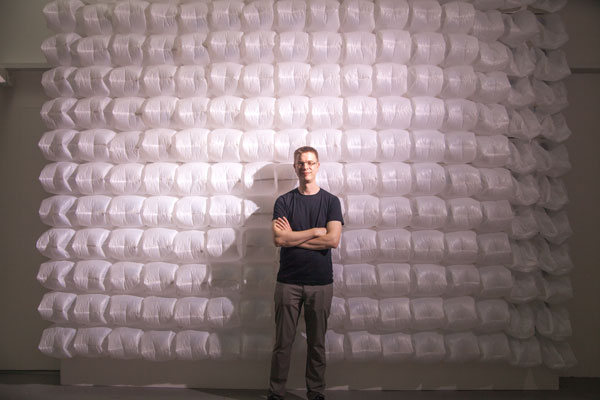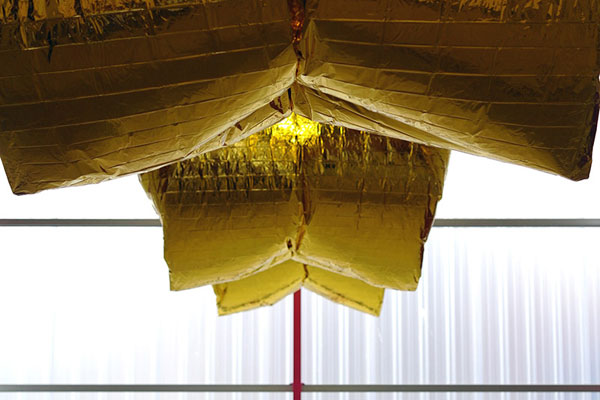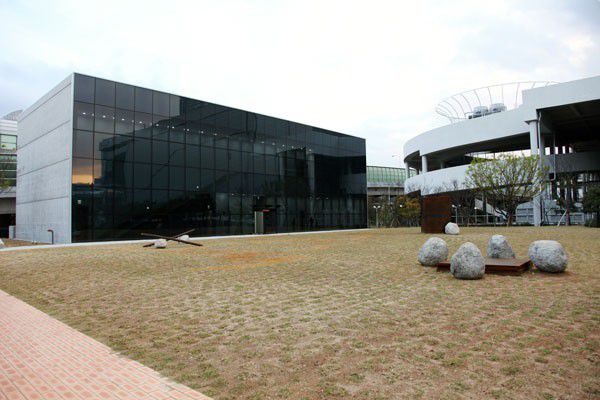Recently exhibited at DECK and VivoCity, The Breathing Wall is an art installation that creates interactivity out of air, 96 plastic bags and customised electronics, made by international media artist, Nils Völker, in collaboration with Philips.

April 15th, 2015
Nils Völker creates artworks that lie in the intersection of technology and art through the means of cheap materials and customised electronic parts. Showcased in Singapore for the first time, while exploring the intangible – the air that we breathe – Völker created his signature installation out of 96 ordinary white plastic bags.

The Breathing Wall, DECK, 2015.
Inflated and deflated in controlled rhythms, the wall-mounted installation reacts instantaneously to the movements of its viewer and recomposes itself as soon as it detects zero activity. The bags will then gently wobble to the natural qualities of its environment, creating an organic installation with an atmospheric presence in the various spaces it inhabits.
Similar large scale installations by Völker, made out of different materials such as cushions, have been exhibited in major museums and art spaces worldwide, including an upcoming piece at 21_21 Design Sight in Tokyo. In an email interview, he tells us how he got to experiment with plastic bags.

NINETEEN, The Netherlands, 2015.
How does the installation in Singapore, The Breathing Wall differ from One Hundred and Eight that you created in 2010?
One Hundred and Eight was the very first work based on inflating plastic bags. Back then I had more or less no idea about electronics and not much more about programming. So the technical background of the new installation is completely different and much more elaborate. But from the outside, what the visitor sees is very similar. Since 2010, I’ve realised many different installations, experimenting with cushions of different shapes, sizes, with materials emitting a loud sizzling sound or cushions having light inside but I have always really liked the size and shape of the garbage bags that I used for One Hundred and Eight so this was the perfect opportunity to use them once again.
What led you to become a media artist?
Originally, I have a background as a graphic designer. A lot of coincidences led me to finally become a media artist. Years ago, I was playing around with a Lego-set with which you can build small robots, just for fun during my free time. Over time, my ideas grew bigger and bigger so I switched to real electronics and actually discovered a whole new world.
And in this new world, you took a simple, everyday material and created installations of mesmerizing beauty. Where did this idea stem from and what challenges did you face?
A while ago, I was lucky to get hold of a large number of computer cooling fans for a very good price. So I simply had to buy them, although at that point I had no idea what they could be useful for. When they arrived, I started experimenting with the fans and things I had lying around. Finally, some simple garbage bags turned out to be surprisingly nice when inflated and deflated. In the beginning, the biggest challenges were rather technical, as I had no experience and knowledge in electronics at all. So I had to go through some trials and way more errors. Nowadays, the challenge with this kind of installations is rather the programming of the animation and to find the best ways to create movements on the wall.
What are the technological elements involved?
Each bag is inflated/deflated by two fans which are all individually addressable by a micro controller. There are several custom made circuit boards needed for the communication and switching of the power running the fans.
The exhibition grew over time with alterations to various materials and form. What is next?
Several exhibitions are planned all over the world. A very nice one will be in a Museum called 21_21 Design Sight in Tokyo. It will include Thirty Three, a very large installation of mine which will be moving based on tidal data from Tokyo harbor.
Nils Völker
nilsvoelker.com
A searchable and comprehensive guide for specifying leading products and their suppliers
Keep up to date with the latest and greatest from our industry BFF's!

Create a configuration to suit your needs with this curved collection.

Suitable for applications ranging from schools and retail outlets to computer rooms and X-ray suites, Palettone comes in two varieties and a choice of more than fifty colours.

In the pursuit of an uplifting synergy between the inner world and the surrounding environment, internationally acclaimed Interior Architect and Designer Lorena Gaxiola transform the vibration of the auspicious number ‘8’ into mesmerising artistry alongside the Feltex design team, brought to you by GH Commercial.

Savage Design’s approach to understanding the relationship between design concepts and user experience, particularly with metalwork, transcends traditional boundaries, blending timeless craftsmanship with digital innovation to create enduring elegance in objects, furnishings, and door furniture.
Gregg Buchbinder, owner and CEO of Emeco visited Australia in March. It takes 77 steps to make one of Emeco’s famously indestructible chairs. Watch the video footage here.

A new space has opened for one of Japan and South Korea’s most celebrated artists, Lee Ufan, at the Busan Museum of Art. Joanna Kawecki reports.
The internet never sleeps! Here's the stuff you might have missed

Leading the field in terms of ergonomics, this high-end office furniture from Buro is also designed with the evolving needs of the modern workplace in mind.

London-based Carmody Groarke and Paris-based TVK have been announced as winners of a milestone competition for the new Bibliothèque nationale de France conservation centre.